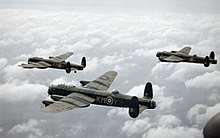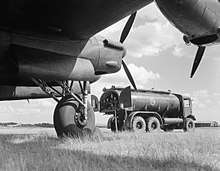Operation Robinson
| Operation Robinson | |||||
|---|---|---|---|---|---|
| Part of Second World War | |||||
 Lancasters prepare to take off in the afternoon | |||||
| |||||
| Belligerents | |||||
|
|
| ||||
| Commanders and leaders | |||||
|
| |||||
| Strength | |||||
| 94 Lancaster bombers | |||||
| Casualties and losses | |||||
|
1 aircraft crashed at the target, 7 aircrew killed | approx. 250 French civilians killed | ||||
| No significant damage inflicted upon the Schneider Works. | |||||
The RAF bombing raid against the Schneider Works at Le Creusot, known as Operation Robinson, was undertaken during the daylight hours of 17 October 1942. The mission was assigned to No. 5 Group, which had converted to the new Avro Lancaster. The Lancaster’s large lift capacity and high speed gave reason for optimism that the raid might succeed.
Background
The Schneider Works was a French plant that produced steel, rails, locomotives, artillery and other armaments. It was largely viewed as the French equivalent of Germany's Krupp Works, and was located in Le Creusot in south central France. To reach it would require flying 300 miles over occupied territory.[1]
Bomber Command had withdrawn its aircraft from daylight attacks after suffering heavy losses attempting daylight bombing raids over the Heligoland islands in the North Sea and over France during the first half of 1940.[2] Since that time Bomber Command operations against German industry were almost exclusively conducted under the cover of night.[3] However, the German war effort was being supported by factories in the occupied countries as well.[4] These targets presented a problem, as bombing them at night would necessarily result in significant casualties among civilians, whose desire to resist the occupiers was being cultivated by Britain. To strike at such targets, Bomber Command would have to attempt attacks in the clear light of day. They did so against selected targets throughout the course of the war. The Le Creusot raid was one such example.
A similar raid six months earlier against the MAN U-boat engine plant in Augsburg had not ended well. Bomber Command sent 12 Lancasters on a long run across France to attempt an accurate daylight strike against the plant. The RAF ran heavy fighter sweeps and bombing attacks on coastal targets to distract German defenses. Nevertheless, while crossing northern France the force was attacked by 20 Me 109s and 4 of the Lancasters were shot down. Flak claimed 3 more over the target.[5] Only 5 aircraft made it back from the raid, a 58% loss rate, and all those that did get back had suffered significant battle damage. As for the MAN plant, it continued to produce U-boat engines without apparent disruption. Daylight attacks against defended targets appeared to be no more practical in 1942 than they had been in 1940.[6] It was hoped the high loss rate would not be repeated in the raid against the Schneider Works.
Planning

For Arthur Harris, Bomber Command's commander in chief, the Schneider plant was the highest priority target in France. To minimize loss of life to French civilians any attack on the plant would have to be made during the day. In his arsenal he had a new bomber in service that was now coming to the force in significant numbers. A four engine aircraft, the Avro Lancaster had excellent range, a tremendous lift capacity and was fast. It was hoped that this would be enough to tip the scales in favor of the bomber crews.
Flying a direct route was out of the question. German fighter bases were concentrated in northern France, Belgium and Germany, and with no fighter escort available after the first 200 miles German fighter aircraft would decimate the attackers.[7] The plan formulated was to take advantage of the range of the Lancaster and send the force out over the ocean, bringing them in to the target from the west. The planes would fly at low level to avoid radar detection. The aircraft would leave in the afternoon, make their attack as light faded, and then fly a direct return under the cover of darkness. It was hoped that the new aircraft would be fast enough to avoid German defenses and would carry a large enough bomb load to cause significant damage to the target.[1]

No. 5 Group RAF was the only Group that had completed the conversion to the Lancaster. Harris assigned the entire Group, all nine squadrons, to attack the target. On 1 October Harris pulled them out of the night offensive against Germany and the Group began training for the attack.
Bomber Command crews were trained to fly on their own at altitude in trail and during the night.[8] The crews were unfamiliar with low level flying, and they did not perform formation flying. 5 Group began to practice, starting with low numbers of aircraft flying together at low altitude and slowly building up until the entire Group was flying together in loose formation.[1] With this strange sort of flight training there was much debate among 5 Group crews as to what the target might be. The tension was heightened by several false alarms when the aircraft were fueled, armed with bombs and placed in readiness. These were potential go days, but each time the mission had been scrubbed due to projected poor weather over the target. Harris needed clear weather over Le Creusot to give his crews the best chance of hitting the plant while avoiding French civilian casualties.
On 17 October 1942 the weather was declared right. Operation Robinson was on.[1]
The raid
94 Lancasters took off in mid-afternoon and formed up before heading south and over the ocean. 88 of the aircraft were committed to the main target, while 6 were to fly on to nearby Montchanin to knock out the coal fueled transformer station located there, which supplied electrical power to the plant.[1]
The Group was led by Wing Commander L.C. Slee, the CO of 49 Squadron. Slee had been in command of 49 Squadron since 14 May 1942.[9] Following his squadron out over the Atlantic was 9 Squadron, 44 Squadron, 50 Squadron, 57 Squadron, 61 Squadron, 97 Squadron, 106 Squadron and 207 Squadron. At the head of 106 Squadron was Guy Gibson, who would go on to fame with 617 Squadron.

The Group flew south out over the Bay of Biscay at 1,000 feet, then turned 90 degrees, dropped altitude down to 100 feet and headed in towards France.[10] The Group flew over the island of Île d'Yeu, some 48 miles south of St. Nazaire, potentially alerting the Germans to their approach. The nearest German fighter squadron was based at Lorient, protecting U-Boats pens there. The Group reached the coast, but encountered no German response. The Lancasters flew on, racing toward their target over the 300 miles of French countryside at tree-top height. Four aircraft suffered minor damage from bird strikes and two men were injured, but the low level flying resulted in no serious accidents going in.[9] The Group navigator brought the force right on course to the navigational pinpoint of Nevers, at the confluence of the Allier and the Loire. Here they made a slight bend to the right, placing them on track for Le Creusot. Over the last 60 miles the Group climbed, staggering the squadrons between 2,500 and 7,500 feet for the release of their bombs. They arrived at Le Creusot at dusk, with enough light to see the target and the soon approach of darkness to cover their retreat. They found almost no Flak over the target.[9] Visibility was excellent and the target easily identified. The Group quickly passed overhead, with the bulk of the formation dropping its bombs over a 7-minute period while six Lancasters continued on with their loads to Montchanin. With bombs gone the crews turned north and headed for home. At the debrief most crews reported their bombing had been accurate. No aircraft were lost in the attack on the Schneider Works. At Montchanin one Lancaster came in too low, caught the roof of a building and crashed into the ground beyond.[10]
Results
Though casualties were extremely light, the raid was a disappointment. Images obtained by a high level photo-reconnaissance Spitfire the following day showed many of the bombs had in fact fallen short of the target, striking the homes of the plant's French workers.[9] Though boldly planned and carried out, the raid was a failure.[10] A repeat raid would not be undertaken until bomber command crews could demonstrate greater accuracy. Such techniques were developed the following year when Leonard Cheshire became commanding officer of 617 Squadron. There, he and Mick Martin developed low level marking techniques that provided the necessary accuracy to destroy a target in the middle of a town or city at night with minimal loss to the civilians in the occupied territories.[11]
References
- Citations
- 1 2 3 4 5 Ashworth 1995, p. 67.
- ↑ Ashworth 1995, pp. 24-26.
- ↑ Maynard 1996, pp. 22-23.
- ↑ Klemann and Kudryashov 2013.
- ↑ Murray 1989, p. 128.
- ↑ Maynard 1996, p. 56.
- ↑ Morgan and Shacklady 1993, p. 172.
- ↑ "Anderson, Ian Gilliland (Oral history)". Imperial War Museum. Retrieved 14 December 2017.
- 1 2 3 4 "Group Captain L C Slee, DSO DFC and Bar". William Farr C of E Comprehensive School. Retrieved 3 February 2018.
- 1 2 3 Ashworth 1995, p. 68.
- ↑ Ashworth 1995, p. 93.
- Bibliography
- Ashworth, Chris RAF Bomber Command 1936-1968 Somerset, UK: Haynes Publishing (1995). ISBN 1 85260 308 9
- Klemann, Hein A M and Sergei Kudryashov Occupied Economies: An Economic History of Nazi-Occupied Europe, 1939-1945 London : Berg Publishers, 2013.
- Maynard, John Bennett and the pathfinders London: Arms and Armour, (1996).
- Morgan, Eric B. and Edward Shacklady. Spitfire: The History (4th rev. edn.). London: Key Publishing, 1993. ISBN 0-946219-10-9.
- Murray, Williamson Strategy for defeat: the Luftwaffe, 1933-1945 Maxwell Air Force Base, Ala. : Air University Press, (1989)[1983]. ISBN 978 0 933852 45 7.